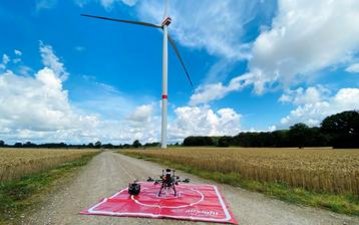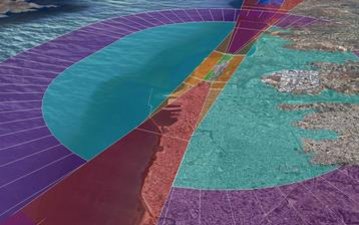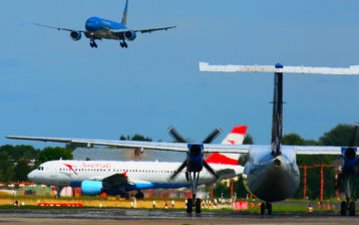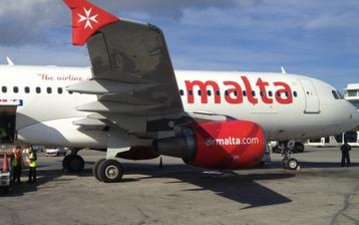Overview
Air operations require a permanent monitoring and assessment of the environment surrounding an aerodrome from developments and activities that may adversely affect the safety or significantly affect the regularity of operations of aeroplanes.
This process, called "aerodrome safeguarding", shall facilitate the safe integration of new development around aerodromes or air traffic control facilities. Its purpose is to protect:
- the airspace around an aerodrome to ensure no obstructions may cause danger to aircraft;
- the integrity of communication, navigation and surveillance (CNS) facilities by preventing reflections and diffractions of the radio signals;
- aeronautical lighting by ensuring that they are not obscured and that any proposed lighting could not be confused for aeronautical lighting;
- aerodrome operations from interference by construction works;
- aircraft from the risk of collision with obstacles through appropriate lighting;
- aircraft from the risk of obstacle induced effects such as turbulence as well as glint and glare.
While regulations may be at a first sight restrictive, these also allow a great flexibility to enable developments - provided a systematic assessment of the possible impacts on aviation is conducted and demonstrate that the safety and regularity of air operations is not compromised.
Such assessment, also known as "aeronautical study" is one of the core competences of airsight. Not only have we conducted hundreds of such assessments and are accredited or recognized by several aviation authorities to provide such services to project developers, but we also contribute to the development of the national and international regulations to make aviation safer.
Our objective and added value is to find operational or technical solutions meeting the needs of airport operators, airspace users and project developers, and our experience in this field is almost unprecedented.
Obstacle Limitation Surfaces (OLS)
Analysis of the airspace around aerodromes to be maintained free from obstacles

International regulations from the International Civil Aviation Organization (ICAO) as described in Annex 14 Vol. I as well as regulations from European Union Aviation Safety Agency (EASA) as described in the CSADRDSN specify airspace around aerodromes to be maintained free from obstacles.
For that purpose, Obstacle Limitation Surface (OLS) are described, which ideally shall not be penetrated by an object.
airsight assists aerodromes and regulators to develop the applicable OLS and to identify penetrations thereof.
Obstacle Free Surfaces (OFS) and Obstacle Evaluation Surfaces (OES)
Establishment of the new OLS and development of tailored surfaces

The ICAO Annex 14 Obstacle Limitation Surfaces (OLS) have origins in the 1950s and were established to ensure the safety of aeroplane operations. History shows that the OLS become penetrated by new obstacles world-wide, and it becomes more difficult to protect the surfaces against new obstructions.
The reasons are manifold and include unclear objectives of the OLS, inconsistencies between ICAO Annex 14, Annex 6, and PANS OPS requirements as well as unclear adequacy between the obstacle requirements of the surfaces and the complex impact of obstacles on the operations.
To address the deficiencies of the current OLS, the ICAO Obstacle Limitation Surfaces Task Force (OLSTF) proposes to replace current OLS by a new twofold concept of Obstacle Free Surfaces (OFS) and Obstacle Evaluation Surfaces (OES). Furthermore, a new code systematic, the aeroplane design groups (ADG), for the design of the OFS and OES is foreseen.
airsight assists aerodromes and regulators to understand the new concept and to develop the new Obstacle Free Surfaces (OFS) and Obstacle Evaluation Surfaces (OES).
Moreover, tailored OES may be established specific to the needs of an aerodrome, enabling more efficient use of the aerodrome surroundings.
Aeronautical Studies
Assessment of OLS infringements on safety and regularity of operations of aeroplanes

Physical Safeguarding is a process aiming at preventing collisions between aircraft and obstacles - such as new constructions or objects. It consists in controlling that obstacles do not infringe relevant obstacle protection surfaces (e.g. ICAO Annex 14 Obstacle Limitation Surfaces).
In many cases however, infringements cannot be avoided. Such penetrations of the Obstacle Limitation Surfaces (OLS) may be acceptable, if an obstacle assessment or aeronautical study shows that there is no adverse impact on safety of flight operations. On the other hand, objects below the OLS or beyond the limits of the OLS may have an impact.
The assessment of obstacles around airports and their impact on flight operational safety is a core competency of our team: we have conducted over 100 projects in this field since 1999, and are internationally one of the most renowned experts in this field.
Often, such analysis includes aspects such as:
- analysis against the ICAO Annex 14 and EASA CS-ADR-DSN Obstacle Limitation Surfaces (OLS) incl. obstacle free zone (OFZ) and other relevant surfaces;
- assessment of the impact on instrument approach and departure procedures according to criteria of ICAO PANS-OPS (ICAO Document 8168);
- assessment of visual flight operations such as approach, departure and circuit patterns;
- assessment of the visual phase of (instrument) approach procedures and visibility of visual landing aids;
- assessment of the impact on contingency take-offs with one engine inoperative according to criteria of ICAO Annex 6 and EASA Air OPS.
Depending on the outcome of the risk assessment, mitigation measures might be derived to ensure that safety is not compromised.
Such mitigation measures, if needed, may include optimization of the proposed development and adjustment of local flight procedures or operational measures.
Wind Turbines and Aviation Safety
Support for project developers to ensure compatibility with aviation safety

Large wind turbines may have a significant impact on safety and regularity of aircraft operations – incl. risk of collision, turbulences as well as interference with communication, navigation and surveillance (CNS) facilities.
airsight assists wind farm developers to resolve complex wind farm planning issues related to aviation. Based on impact and risk assessment, potential mitigation measure may be required and are developed.
Since April 2020 airsight has been entitled by the German Federal Ministry of Transport (BMVI) as authorized entity to verify aircraft detection lighting systems (ADLS).
Read more
Obstacle Induced Effects
Assessment of obstacle induced effects such as turbulence, glint and glare, etc.

In addition to the impact on the airspace around an aerodrome, developments may also induce further effects potentially having an impact on safety of flight operations.
For instance, wind turbines as well as objects close to the runway may cause wind shear and turbulences. Furthermore, chimneys produce thermal plumes.
Solar panels on and off aerodromes cause glint and glare potentially impacting pilots. Concentrated solar power plants (CSP) may even have a larger impact on safety.
airsight assists project developers in assessing the potential effects induced by developments and to derive mitigation measures if needed.
CNS Safeguarding
Technical Safeguarding of Communication, Navigation and Surveillance (CNS) facilities

CNS systems are very vulnerable to adverse effects caused by physical obstacles such as buildings, cranes, wind turbines as well as mobile objects (aircraft, construction equipment).
The rules and associated concepts introduced by these regulations are complex and frequently misunderstood by the stakeholders. As protection surfaces are very restrictive, it often leads to conflicts between developers and airspace users – though, in many cases, technical solutions may be available to resolve or minimize adverse impacts.
airsight assists project developers in the project planning phase in minimizing interference issues with CNS systems, while avoiding too costly measures (design revisions, relocation, or reorientation), as well as in obtaining the relevant approvals from the authorities and air navigation service providers.
As a first step, an analysis CNS safeguarding surfaces may be conducted in order to identify the need for detailed CNS assessment. The CNS safeguarding surfaces, or building restricted areas (BRA), typically considered for the analysis are based on ICAO EUR Doc 015 “Guidance Material on Managing Building Restricted Areas”. If needed, further international provisions of CNS safeguarding surfaces (e.g. from the U.K.) may be applied.
Proposed developments infringing the CNS safeguarding surfaces may have an impact on CNS facilities and therefore need further detailed assessment. Depending on the CNS facility affected, different methods may be applied.
For Instrument Landing Systems (ILS), ILS computer modelling is conducted to assess the effects on the ILS glide path and localizer antennas. Such modelling calculates the difference in path length between signals arriving at an aircraft direct from the radiating antenna and those reflected from buildings and structures. The direct and reflected radio signals are then combined to determine the signal being received by an aircraft. The assessment of possible interferences on the signal in space will be conducted, based on the interpretation of plots generated by the model against ICAO Annex 10 tolerances.
To determine the potential impact on DVOR facilties induced by wind turbines, the angular error may be simulated by a model which was developed as part of a research project in Germany (WERAN / WERANplus). This formula is also applied by the German air navigation service provider “Deutsche Flugsicherung” (DFS) and accepted by the responsible German authority (BAF).
In other cases, line-of-sight analysis may be conducted, too.

In support project developers and urban planning, height restrictions around aerodromes required by the needs of aviation may be shown on so-called safeguarding maps.
airsight assists aerodromes and regulators to develop tailored maps meeting the local requirements.
Typically, such safeguarding maps combine height restrictions induced by the aerodromes Obstacle Limitation surfaces (OLS) as defined by ICAO Annex 14 or national regulations as well as local instrument flight procedures and their criteria as defined by ICAO Doc 8168. Depending on the needs of the local stakeholders further aspects may be included as well, such as visual flight operations and CNS safeguarding surfaces and more.

Do you have a project that you'd like to discuss with us?
Send us a message, we will review your request and get back to you!






